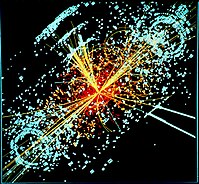
Photo from wikipedia
Neutrino-nucleus scattering $\nu A\to \nu A$, in which the nucleus conserves its integrity, is considered. We show that elastic interactions keeping the nucleus in the same quantum state lead to… Click to show full abstract
Neutrino-nucleus scattering $\nu A\to \nu A$, in which the nucleus conserves its integrity, is considered. We show that elastic interactions keeping the nucleus in the same quantum state lead to a quadratic enhancement of the corresponding cross-section in terms of the number of nucleons. Meanwhile, the cross-section of inelastic processes in which the quantum state of the nucleus is changed, essentially has a linear dependence on the number of nucleons. These two classes of processes are referred to as coherent and incoherent, respectively. The coherent and incoherent cross-sections are driven by factors $|F_{p/n}|^2$ and $(1-|F_{p/n}|^2)$, where $|F_{p/n}|^2$ is a proton/neutron form-factor of the nucleus, averaged over its initial states. The coherent cross-section formula used in the literature is revised and corrections depending on kinematics are estimated. As an illustration of the importance of the incoherent channel we considered three experimental setups with different nuclei. Experiments attempting to measure coherent neutrino scattering by solely detecting the recoiling nucleus, as is typical, might be including an incoherent background that is indistinguishable from the signal if the excitation gamma eludes its detection. However, as is shown here, the incoherent component can be measured directly by searching for photons released by the excited nuclei inherent to the incoherent channel. For a beam experiment these gammas should be correlated in time with the beam, and their higher energies make the corresponding signal easily detectable at a rate governed by the ratio of incoherent to coherent cross-sections. The detection of signals due to the nuclear recoil and excitation gammas provides a more sensitive instrument in studies of nuclear structure and possible signs of new physics.
Journal Title: Physical Review D
Year Published: 2018
Link to full text (if available)
Share on Social Media: Sign Up to like & get
recommendations!